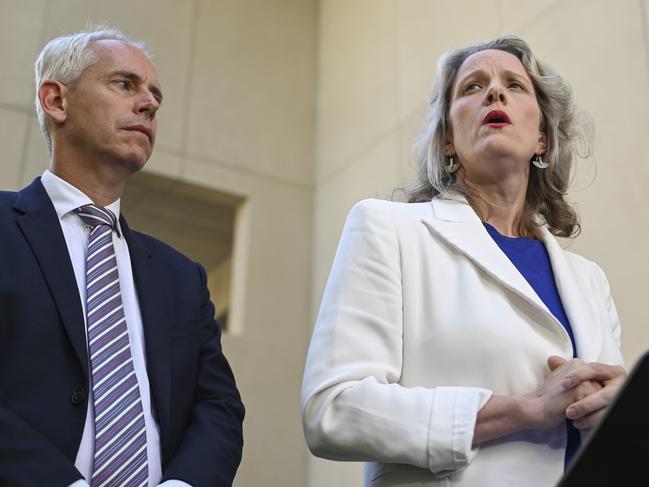Anthony Albanese urged to steal New Zealand’s plan to get on top of surging immigration
Anthony Albanese is under attack again over runaway immigration, with critics urging him to steal a solution from across the ditch.
Business
Don't miss out on the headlines from Business. Followed categories will be added to My News.
Australia is being urged to follow the lead of New Zealand in dramatically slashing the country’s migrant intake and tightening rules surrounding sought-after visas.
Four months after coming to power, the coalition government across the ditch has taken steps to address “unsustainable” levels of immigration, after a near-record high of 173,000 people arrived in the country last year.
New Zealand Immigration Minister Erica Stanford yesterday unveiled a suite of reforms, including changes to the main temporary work visa, an introduction of an English language requirement, and a minimum skills threshold.
The maximum amount of time a low-skilled foreign worker can remain in the country has been cut from five years to three.

Here at home, the Opposition’s spokesman for immigration and citizenship Dan Tehan urged Prime Minister Anthony Albanese to take a leaf out of the Kiwis’ book.
“Labor should look to New Zealand to get some help to fix the mess they have created,” Mr Tehan told news.com.au.
But a leading expert said the intensifying immigration debate is overly political and without context, and claims Australia is already well ahead of the Kiwis in terms of policy setting.
Brawl over ‘Big Australia’
In the year to June 2023, a record 518,000 people from abroad arrived in Australia – well-above budget projections and miles away from the pre-Covid average of 220,000 per year.
As well as contributing to the largest increase in Australia’s population in decades, the share of net migration as a proportion of the total resident base was double that seen since post-World War II.
Forecasts indicate another 375,000 will have arrived in the year to June 2024, bringing the two-year total to a staggering 893,000.
Some economists say the influx is responsible for a large chunk of the cost-of-living and housing crises, by both contributing to inflation and fanning the flames of the rental crunch.

Mr Tehan said the government had allowed the immigration system to run out of control without having “a plan to deal with the pressure on housing, infrastructure, government services and the environment”.
“Labor’s Big Australia saw a record 548,800 people arrive in the year to September.
Australians are rightly asking: where are all these people going to live?” he said.
“Unprecedented arrivals under the Albanese Labor Government are exacerbating housing shortages and driving up rents because of more competition.”
He said there was “no way” the government could meet its target migration number of 250,000 in the 12 months to June 2025.
“They should be honest with the Australian people about the size of their miss,” he said.
Important context ignored
Peter McDonald is a demography expert with the University of Melbourne’s School of Population and Global Health, as well as chief investigator for the Australian Research Council’s Centre of Excellence in Population Ageing Research.
Contrary to claims from the opposition, Professor McDonald said the government seemed “desperate to reduce net migration” to extent he has “never seen before”.
“We are already way ahead of New Zealand in the same policy space,” he added.

What New Zealand’s reforms do prove is that the migration surge is “not just an issue for Australia” and pointed out that Canada and the United Kingdom are battling similar forces, he said.
And behind our mammoth net migration figure of 518,000 people in 2023 was “instructive” context, he added.
“The extremely high level of net migration in the 2022-23 financial year was all about temporary migration. Net temporary migration for the year was 477,160, while net permanent migration was just 57,570.
“Of course, people move from temporary status to permanent status onshore, but that movement is limited by the planned size of the government’s permanent migration program, the size of which has remained largely unchanged at around 210,000, including humanitarian migrants.
“In other words, the permanent population of Australia just continues to grow annually by the same numbers that it has grown for the past decade.”
On top of that, he said the average annual net migration rate after the onset of Covid was lower than pre-pandemic levels.
“In other words, if Covid had not occurred, net migration in the four years to 30 June 2023 would have been higher than it actually was.”
Immigration Minister Andrew Giles’ office referred a request for comment for this story to the Department of Home Affairs.
No response was received by deadline.

Significance of reforms ‘overstated’
Last year, a scathing review into Australia’s migration system ordered by the government was handed down, describing it as broken, inefficient and unfair, especially when it comes to temporary skilled migration.
The report called for “major reform” rather than “tinkering and incrementalism” and in its wake, the government announced a new migration strategy in December.
Among the raft of changes was a commitment to slash the migrant intake to 375,000 people in the year to June 2024, and to 250,000 in the year following.
However, the cuts aren’t as dramatic as they seem, Australian Catholic University research fellow Rachel Stevens said.
“The government says these changes are the ‘biggest reforms in a generation’ [and] it’s been reported the reforms will ‘dramatically cut’ the immigration intake, but don’t be fooled by the hyperbole,” Dr Stevens wrote in analysis for The Conversation.
Rather than a complete overhaul, Dr Stevens said the reforms represent several “long overdue remedies” focusing on misuse of international student visas, migrant worker exploitation, and an overly complex and inefficient bureaucracy.

In addition, she claimed cuts to intake levels are “overstated” and largely the result of “a natural evening out of migration patterns … post-pandemic”.
“Even the Department of Immigration acknowledges the spike in arrivals is ‘temporary’, a phenomenon labelled as ‘the catch-up effect’ by the Australian Bureau of Statistics. If the current circumstances are only transitory, one wonders why the government is so keen to cut numbers.”
There are an estimated two million people residing in Australia on temporary visas.
Most of them are New Zealand citizens, international students, temporary skilled workers and recent graduates.

The government has spoken repeatedly about its intention to end Australia’s reliance on temporary migrant workers and offer more achievable pathways to permanent residency.
Since coming to power the Albanese government has made no secret of its plan to end Australia’s reliance on temporary migrant workers and offer them achievable pathways to permanent residency.
It has introduced a new Skills in Demand visa and streamlined permanent residency requirements for other temporary skilled migrants.
Another big change was ‘decoupling’ migrant visas from sponsoring employers, giving someone 180 days to find a new work sponsor if they want to switch jobs, an increase from 60 days previously.
How temporary is ‘temporary’?
Professor McDonald said it remained unclear whether the “very large number” of temporary arrivals seen in 2022-23 is indeed temporary, “or whether it represents a new level of demand for residence in Australia”.
“The main entry channel is the student visa and [it’s] early days yet but there are indications that there is a new level of demand. For example, the range of countries from which students come has widened.”

The government has vowed to close so-called loopholes in the international education sector by cracking down on dodgy providers.
“It is important to remember most of the recent growth in international enrolments is in the higher education sector not the vocational education and training sector that is so often maligned,” Dr Stevens said.
“Measures to reduce the number of international students, such as increasing English language proficiency, have been overstated in the media.
“The new migration strategy will only increase the International English Language Testing System requirement for a student visa from a score of 5.5 to 6.0.
“Besides, the government can’t have it both ways: for years it has been underfunding universities. It cannot expect universities to turn off the revenue tap of international students when there are no alternative funding sources available.”
A double-edged sword
Most economists agree that migration is beneficial for the stability – and hoped growth – of the country’s economy.
It has proven to be especially crucial in recent times as key industries battle acute skilled labour shortages, especially in construction and home-building.
“In employment terms, the effects appear to have been very positive,” Professor McDonald said.
“Unemployment is low and the very large number of retirees from the Baby Boomer generation are being replaced. Services are being provided that would not otherwise have been available – the aged care sector, for example, but also hospitality.”

And migration expands the taxpayer pool, boosting government revenue and helping the balance the budget.
“The substantial issue is rental housing,” Professor McDonald said.
“Prior to Covid, a lot of dedicated student housing was built in the big cities – high-rise studio apartment blocks. This ceased with Covid, along with a lot of other building [projects]. This means there is a shortage of dedicated student housing and international students have to enter the conventional rental market.
“This is just one of the demand side factors affecting the rental market. Others are conversions from long-term to short-term rental, the surge of house renovations, and the cost of home purchase.
“On the supply side, there are also major issues such as the rising costs of materials, the shortage of labour and companies going bust. Overall, a wicked problem that is not going to go away easily.”
Originally published as Anthony Albanese urged to steal New Zealand’s plan to get on top of surging immigration





